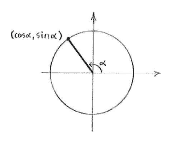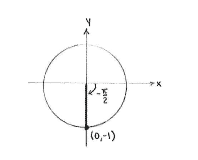Lösung 4.2:3a
Aus Online Mathematik Brückenkurs 1
(Unterschied zwischen Versionen)
K (Lösning 4.2:3a moved to Solution 4.2:3a: Robot: moved page) |
|||
| Zeile 1: | Zeile 1: | ||
| - | {{ | + | A useful technique for calculating the value of a trigonometric function for angles that don't lie between |
| - | < | + | <math>0</math> |
| - | + | and | |
| + | <math>{\pi }/{2}\;</math> | ||
| + | is to use the unit circle. If we draw a line which starts at the origin and makes a certain angle relative to the positive part of the | ||
| + | <math>x</math> | ||
| + | -axis, we can see that the cosine of that angle is the | ||
| + | <math>x</math> | ||
| + | -coordinate of the point of intersection between the line and the unit circle. In the same way, the sine of the angle is the | ||
| + | <math>y</math> | ||
| + | -coordinate of the intersection point. | ||
| + | |||
| + | |||
[[Image:4_2_3_a1.gif|center]] | [[Image:4_2_3_a1.gif|center]] | ||
| + | In this case, we see immediately that | ||
| + | <math>\text{sin}\left( -\frac{\pi }{2} \right)\text{ }=\text{ }-\text{1}</math>. | ||
| + | |||
| + | |||
| + | |||
[[Image:4_2_3_a2.gif|center]] | [[Image:4_2_3_a2.gif|center]] | ||
Version vom 11:47, 28. Sep. 2008
A useful technique for calculating the value of a trigonometric function for angles that don't lie between \displaystyle 0 and \displaystyle {\pi }/{2}\; is to use the unit circle. If we draw a line which starts at the origin and makes a certain angle relative to the positive part of the \displaystyle x -axis, we can see that the cosine of that angle is the \displaystyle x -coordinate of the point of intersection between the line and the unit circle. In the same way, the sine of the angle is the \displaystyle y -coordinate of the intersection point.
In this case, we see immediately that \displaystyle \text{sin}\left( -\frac{\pi }{2} \right)\text{ }=\text{ }-\text{1}.


